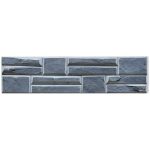Cultured Stone Retaining Walls An Aesthetic and Durable Solution for Landscaping

Introduction:
Retaining walls serve a crucial purpose in landscaping, providing essential structural support to prevent soil erosion and manage changes in elevation. While functionality is the primary concern, there is no reason why retaining walls cannot be visually appealing as well. Cultured stone retaining walls have emerged as a popular choice for homeowners and landscape designers due to their ability to combine functionality with aesthetics. In this article, we will explore the various aspects of cultured stone retaining walls, including their benefits, installation process, design options, and maintenance requirements.

https://www.fs-slate.com/step-stone/ : Understanding Cultured Stone
1.1 Definition and Composition of Cultured Stone:
- Cultured stone, also known as manufactured or faux stone, is a man-made product designed to resemble natural stone.
- It is typically composed of lightweight concrete or other materials, mixed with pigments and aggregates to mimic the texture, color, and appearance of real stone.
- Cultured stone offers a wide range of design possibilities, as it can emulate various types of stone, such as limestone, slate, flagstone, or even brick.
1.2 Advantages of Cultured Stone:
- Cost-effective: Cultured stone is often more affordable than natural stone, making it a popular choice for budget-conscious homeowners.
- Versatility: The ability to replicate different stone types allows for a diverse range of design options to suit any landscaping style.
- Lightweight: Compared to natural stone, cultured stone is lighter, making it easier to handle during installation.
- Durability: Cultured stone is resistant to weathering, fading, and cracking, ensuring long-lasting beauty and functionality.
- Eco-friendly: Many cultured stone products are made from recycled materials, reducing the environmental impact of extraction and quarrying.
Section 2: Installation Process of Cultured Stone Retaining Walls
2.1 Planning and Site Preparation:
- Assess the site and determine the purpose and dimensions of the retaining wall.
- Obtain necessary permits and consult with local building codes to ensure compliance.
- Excavate the area, removing any existing materials and debris to create a level surface for the retaining wall.
2.2 Foundation and Base Construction:
- Prepare a solid and level foundation, typically using compacted gravel or crushed stone.
- Install a drainage system behind the retaining wall to prevent water buildup and pressure.
2.3 Building the Retaining Wall:
- Start by laying the first course of cultured stones, ensuring proper alignment and levelness.
- Apply mortar or adhesive to the back of each stone, securely attaching them to the foundation.
- Repeat the process for subsequent courses, staggering the joints for added stability and aesthetics.
- Use a masonry saw or chisel to cut stones to fit the desired shape and size, ensuring a seamless appearance.
- Install additional reinforcement, such as geogrid or steel reinforcements, for larger or taller retaining walls.
- Finish the top of the retaining wall with capstones or coping stones for a polished look.
Section 3: Design Options for Cultured Stone Retaining Walls
3.1 Color and Texture Selection:
- Cultured stone is available in a wide array of colors, ranging from earth tones to vibrant hues, allowing for customization to match the surrounding landscape.
- Different textures, such as rough or smooth surfaces, can be chosen to create a specific ambiance or complement other elements in the outdoor space.
3.2 Patterns and Arrangements:
- Cultured stone retaining walls can be constructed using various patterns, including stacked, random, or ashlar patterns, to achieve different visual effects.
- Incorporating built-in seating, planters, or other architectural features can enhance the functionality and aesthetics of the retaining wall.
3.3 Integration with Landscaping Elements:
- Cultured stone retaining walls can be seamlessly integrated with other outdoor features, such as patios, pathways, or stairs, to create a cohesive design.
- Adding lighting fixtures or water features can further enhance the overall ambiance and functionality of the retaining wall.
Section 4: Maintenance and Care of Cultured Stone Retaining Walls
4.1 Cleaning and Stain Removal:
- Regularly clean the surface of the cultured stone retaining wall using a mild detergent and water to remove dirt, dust, or organic debris.
- Avoid using abrasive cleaners or harsh chemicals that may damage or discolor the stone.
- Address any stains promptly, using specialized stone cleaners or poultice products as recommended by the manufacturer.
4.2 Inspecting and Repairing:
- Periodically inspect the retaining wall for any signs of damage, such as cracks, chips, or loose stones.
- Repair any minor damages promptly to prevent further deterioration or structural issues.
- Consult with a professional if extensive repairs or replacements are required.
4.3 Protection from Environmental Factors:
- Apply a high-quality sealant or water repellent to protect the cultured stone from moisture, UV rays, and other environmental factors.
- Ensure proper drainage and address any water-related issues to prevent water damage or erosion behind the retaining wall.
Conclusion:
Cultured stone retaining walls offer an ideal balance between functionality and aesthetics, providing a durable and visually pleasing solution for landscaping projects. With their cost-effectiveness, versatility, and durability, cultured stone retaining walls have become a popular choice for homeowners and landscape designers alike. By understanding the composition, installation process, design options, and maintenance requirements of cultured stone retaining walls, individuals can make informed decisions when incorporating them into their outdoor spaces. Whether it's for residential or commercial purposes, these attractive and durable retaining walls can transform any landscape into a stunning and functional masterpiece.
